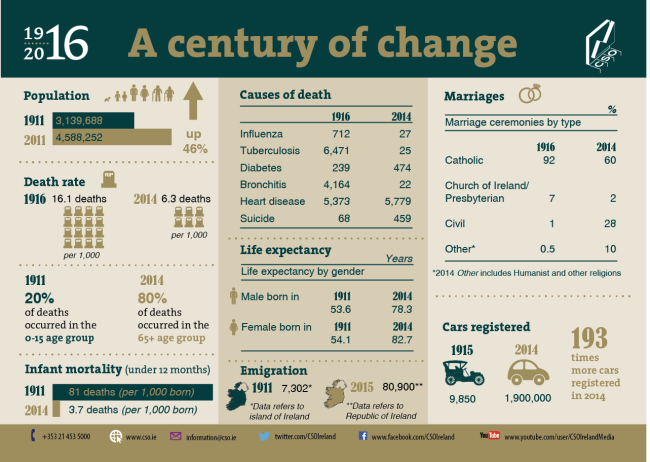To mark the centenary of 1916 the CSO has produced a special publication highlighting life in Ireland around 1916, including a snapshot of what the economy was like at the time.
You may be surprised to learn that in 1916 Ireland was experiencing a period of prosperity. This was due mainly to the positive economic effects of World War I, with a balance of trade surplus in 1916 of £1.5m, and a fiscal surplus of £11m.
The Irish economy at the time was dominated by four industries: Agriculture, Linen production, Shipbuilding and Brewing & Distilling. The first three of these activities were positively impacted upon by the war with increased demand for food, linen and ships directly linked to the war effort. Clearly this prosperity was not shared by all sectors of society with many people in Dublin experiencing extremely poor living conditions.
Dublin was a city of extremes in housing in 1911, when 22% of dwellings were large homes (with 10 or more rooms) and 36% were one room tenements.
By 1916 an estimated 130,000 men from Ireland had joined the British army. Many men and women went to Great Britain to work in munitions factories and hospitals.
The Irish economy in 1916 was by no means industrially backward. Ireland was in the group of middle ranking industrialised countries along with Portugal, the Scandinavian countries, Italy and the Netherlands.
We've put together some interesting stats from the report....

Source: Central Statistics Office
Where did people work?
In 1911 there were 1,273,850 people at work which had grown to 1,807,360 in 2011. In 1911 nearly half of workers were in Agriculture in comparison to just 4.9% in 2011.
Just over a quarter (26.8%) of workers in 1911 worked in manufacturing jobs compared to 8.6% in 2011.
One in ten workers in 1911 worked as a domestic servant, while in 2011 only a few thousand people were working as a domestic servant, less than 0.3% of those at work.
The Professional group of occupations accounted for 8.8% of all workers in 1911. By 2011 this area of work had more than quadrupled and the two groupings of Professional, Technical and Health workers and Clerical, Managing and Government workers accounted for just over 40% of all workers.
The Commercial group of occupations in 1911 covered 5.6% of workers and included Insurance, Banking, Transport and Communications, and Retail and Wholesale trade.
In 2011 there were 2 occupation groups which would cover broadly similar occupations, which together accounted for 21.5% of all workers.
359,700 farms over one acre in 1915
There has been a significant decline in the number of farms in Ireland. In 1915 there were 359,700 farms over one acre and by 2010 this had declined to 139,860 farms over one hectare (equal to 2.5 acres) - a reduction of over 60% in the number of farms.
Dublin and Louth were the counties with the largest percentage decline in the number of farms over the last century. Dublin had a drop of 83% in the number of farms while Louth declined by 72%.
Between 1915 and 2010 there has been a 7% decline in the area farmed in Ireland, from 4,932 to 4,569 thousand hectares. The average farm size in this country has more than doubled, increasing from 14 to 33 hectares, with the average farm size trebling in the counties of Louth, Dublin and Cavan.
Between 1916 and 2010 the amount of land used for growing wheat and barley has trebled in size while the area used for growing potatoes has dropped by over 90%. The area used for growing oats has also decreased by over 90%. On account of the improvements in plant productivity and gains yields per hectare from wheat, oats, barley and potatoes have tripled since 1916.
In the early decades of the 20th century there was seasonal migration from Ireland to England, Scotland and Wales for seasonal employment during the harvest. Around 13,000 people migrated to Britain in 1914 for seasonal employment. Most of these migrants were from Mayo and Donegal.
9,850 cars in Ireland in 1915... compared to 1.9 million in 2014
In 1915 the total number of cars in Ireland was 9,850, a third of them, 3,331, being in Dublin. In contrast, by 2014, there were as many as 1.9 million private cars in the Republic with a quarter of these cars being in Dublin.
Back in 1916 ships were the only method of transport for the movement of people and goods to and from the outside world. There were more than 80 cross-channel sailings per week to Britain from Dublin Port in 1911. There were 38 steamship companies operating across the Irish Sea by 1918, carrying passengers and cargo.
A century ago ports on the island of Ireland handled 26.5 million tonnes of goods. By 2014 47.5 million tonnes of goods were being handled.
In 1916, canals and canalised rivers on the island of Ireland were mainly used for transporting goods. One hundred years later the main uses for these waterways are leisure and recreation.
Dublin had a fleet of 330 electric trams by 1911. Trams in Dublin operated on lines which ran for 95.6 km along the city's roads. The tram service returned to Dublin in June 2004 with the opening of the Luas. By 2013 the Luas Red and Green lines were 37.2km in length and had carried 30.5 million passengers.
There were over 5,632 km of railways on the island of Ireland in 1916 transporting passengers and goods. By 2014, there were 2,384 km of railway tracks which carried 37.8 million passengers on Irish Rail and Dart services.
Back in 1916 there were 964 train stations. By 2014 this figure had reduced significantly to just 144 stations open in the Republic of Ireland.
For more information
Read the full CSO report Life in 1916 Ireland: Stories from Statistics.
Thumbnail image courtesy of the National Library of Ireland. See their 1916 photostream on their Flickr account.